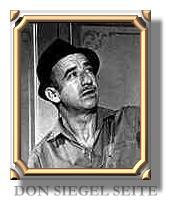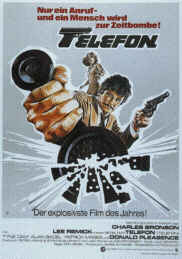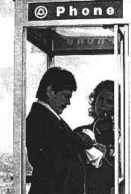 |
|
 |
ANALYSE INFOS |
|---|
 |
|
 |
ANALYSE INFOS |
|---|

 Ein sowjetischer Geheimdienstler und Stalinist bringt durch raffinierte Sabotageakte in den USA die Entspannungspolitik in Gefahr, bevor er durch den eilends eingeschleusten Kollegen getötet wird. (Lex. des Int. Films) |
| Charles Bronson
Lee Remick Donald Pleasence Tyne Daly Alan Badel Patrick Magee Sheree North John Mitchum Al Dunlap Cliff Emmich Burton Gilliam John Hambrick Roy Jenson Ake Lindman Lew Brown Frank Marth Helen Page Camp Hank Brandt Jim Nolan Carl Byrd Kathleen O'Malley George Petrie Robert Phillips Regis J. Cordic Ed Bakey Tom Runyon Derek Rydall Ville-Veikko Salminen Jacqueline Scott John Carter Alex Sharp Peter Weiss Iggie Wolfington Jeff David Carmen Zapata |
- Borzov
- Barbara - Dalchimsky - Putterman - Col. Malchenko - Gen. Strelsky - Marie Wills - Bascom - Taxi Driver - Highway Patrolman - Tankwart - TV Newsman - Doug Stark - Lt. Alexandrov - Petty Officer - Harley Sandberg - Emma Stark - William Enders - Appliance Store Clerk - Navy Lieutenant - Mrs. Maloney - Hotel Receptionist - Highway Patrolman - Doctor - Carl Hassler . - Mrs. Wills' Child - Russian Steward - Mrs. Hassler - Stroller - Martin Callender - Radar Operator - Father Stuart Diller - Maitre d' - Nurse |
Don Siegel
James B. Harris Peter Hyams Stirling Silliphant Michael C. Butler Douglas Stewart Edward Haworth Ted Haworth Vinton Haworth WIlliam F. O'Brien Robert R. Benton Robert Benton Luster Bayless Jane Robinson Edna Taylor Joe Day David Shamroy Hamburger Michael J. Kohut Wiliam L. McCaughey Alfred J. Overton Aaron Rochin Paul R. Baxley, Jr.
|
- Regie
- Produzent - Drehbuch - Drehbuch - Kamera - Musik/Komponist - Schnitt - Production Designer - Production Designer - Production Designer - Art Director - Set Decoration/Design - Set Decoration/Design - Kostüme - Kostüme - Kostüme - Special Effects - Asst. Director - Sound/Sound Designer - Sound/Sound Designer - Sound/Sound Designer - Sound/Sound Designer - Stunts Coordinator |
| "Drehbuch: The screenplay, written
by Peter Hyams, was based on the novel Telefon by Walter Wager. Peter's script
was much too complicated and long. Marty Elfan, the executive producer and
a close friend of Hyams, had him do a complete rewrite. Richard Shepherd,
the head of MGM's Motion Picture Division, was furious with the carelessness
of Peter's revised script, as was Marty. Another writer, Scott Hale, was hired. No one liked his script. then Stirling Silliphant was brought in to do another version. (...) (Richard Shepherd) suggested bringing in another producer, Jim Harris, who had worked for Stanley Kubrick. (...) Jim Harris showed up at my office. He was quite thin, about 5 foot 8, and was on his way to becoming bald. He was a soft-spoken, serious-looking man. I asked him what he thought of the various scripts. He answered directly and immediately.
HARRIS: I don't like them at all. Es wird ein Kommittee gebildet, das über das Drehbuch zu befinden hat. Hypnose und das Gedicht: What amazed me, with all the verbal and written criticisms of the committee, was that no one ever mentioned that the catalyst of the story was impossible to believe. The audience was expected to accept the preposterous notion that, by using drug-induced hypnosis, people can be triggered into committing acts of extreme violence. This was accomplished in the story by lamely telling these people, in person or by telephone, part of a poem. Idiotically, it didn't matter how many years had elapsed between their being hypnotized and their hearing the poem. My only hope was to shoot these sequences so realistically that the audience would be swept into accepting this ridiculous premise. At best, it was a long shot. At least I tried. Rollstuhl-Kamera: On the upper floor, a group of people, including Gregg, waits impatiently for an elevator. It arrives. He pushes in. The doors close. Gregg presses his face against the plexiglass, looking down. He sees Callender walking with singular intensity on to a desending escalator. Gregg's elevator arrives on the ground floor. He roughly pushes out and runs for the descending escalator. To give the sequence as much excitement as possible, we put our camera operator in a wheelchair. As soon as Gregg moved through the elevator door, we spun the wheelchair in a complete circle, picking up Bronson running. I've never seen that shot before or since. It worked beautifully. Ende: The last sequence of the film was shot in three types of weather. It was snowing in the morning. We started shooting, but then a heavy rain stopped us. We started to shoot in the rain, then the sun came out. We started all over again in bright sunlight, this time completing the sequence." Siegel: A Siegel Film. S. 419-433 |